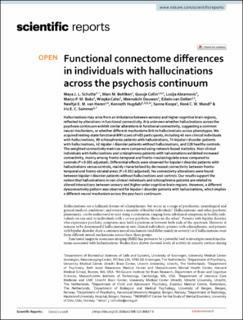| dc.contributor.author | Schutte, Maya J. L. | |
| dc.contributor.author | Bohlken, Marc M. | |
| dc.contributor.author | Collin, Guusje | |
| dc.contributor.author | Abramovic, Lucija | |
| dc.contributor.author | Boks, Marco P. M. | |
| dc.contributor.author | Cahn, Wiepke | |
| dc.contributor.author | Dauwan, Meenakshi | |
| dc.contributor.author | van Dellen, Edwin | |
| dc.contributor.author | van Haren, Neeltje E. M. | |
| dc.contributor.author | Hugdahl, Kenneth | |
| dc.contributor.author | Koops, Sanne | |
| dc.contributor.author | Mandl, René C. W. | |
| dc.contributor.author | Sommer, Iris E. C. | |
| dc.date.accessioned | 2021-07-16T07:50:32Z | |
| dc.date.available | 2021-07-16T07:50:32Z | |
| dc.date.created | 2021-01-18T16:26:08Z | |
| dc.date.issued | 2021 | |
| dc.identifier.issn | 2045-2322 | |
| dc.identifier.uri | https://hdl.handle.net/11250/2764597 | |
| dc.description.abstract | Hallucinations may arise from an imbalance between sensory and higher cognitive brain regions, reflected by alterations in functional connectivity. It is unknown whether hallucinations across the psychosis continuum exhibit similar alterations in functional connectivity, suggesting a common neural mechanism, or whether different mechanisms link to hallucinations across phenotypes. We acquired resting-state functional MRI scans of 483 participants, including 40 non-clinical individuals with hallucinations, 99 schizophrenia patients with hallucinations, 74 bipolar-I disorder patients with hallucinations, 42 bipolar-I disorder patients without hallucinations, and 228 healthy controls. The weighted connectivity matrices were compared using network-based statistics. Non-clinical individuals with hallucinations and schizophrenia patients with hallucinations exhibited increased connectivity, mainly among fronto-temporal and fronto-insula/cingulate areas compared to controls (P < 0.001 adjusted). Differential effects were observed for bipolar-I disorder patients with hallucinations versus controls, mainly characterized by decreased connectivity between fronto-temporal and fronto-striatal areas (P = 0.012 adjusted). No connectivity alterations were found between bipolar-I disorder patients without hallucinations and controls. Our results support the notion that hallucinations in non-clinical individuals and schizophrenia patients are related to altered interactions between sensory and higher-order cognitive brain regions. However, a different dysconnectivity pattern was observed for bipolar-I disorder patients with hallucinations, which implies a different neural mechanism across the psychosis continuum. | en_US |
| dc.language.iso | eng | en_US |
| dc.publisher | Nature Research | en_US |
| dc.rights | Navngivelse 4.0 Internasjonal | * |
| dc.rights.uri | http://creativecommons.org/licenses/by/4.0/deed.no | * |
| dc.title | Functional connectome differences in individuals with hallucinations across the psychosis continuum | en_US |
| dc.type | Journal article | en_US |
| dc.type | Peer reviewed | en_US |
| dc.description.version | publishedVersion | en_US |
| dc.rights.holder | Copyright the authors 2021 | en_US |
| dc.source.articlenumber | 1108 | en_US |
| cristin.ispublished | true | |
| cristin.fulltext | original | |
| cristin.qualitycode | 1 | |
| dc.identifier.doi | 10.1038/s41598-020-80657-8 | |
| dc.identifier.cristin | 1873531 | |
| dc.source.journal | Scientific Reports | en_US |
| dc.identifier.citation | Scientific Reports. 2021, 11, 1108. | en_US |
| dc.source.volume | 11 | en_US |

